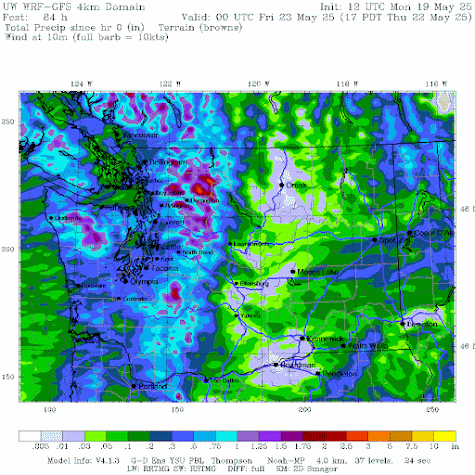The headlines in the Seattle Times and elsewhere are ominous: a low snowpack over Washington State means more wildfires this summer.
Some politicians and state agencies make the same claims. Less snowpack and earlier melt-out produce a drier environment that brings earlier and greater wildfires.
Sounds reasonable, right?
There is a problem with this claim: it is not true.
And there are good reasons why it is not true.
Let's look at the data!
Last night, I plotted the Washington State wildfire area burned (orange) and the WA April 1 snowpack (based on USDA Snotel sites)--blue line-- for 2002-2024. The latter was provided by Mark Albright, past Washington State Climatologist. April 1 snowpack is the classic measure of snow amount before the summer season.
You will notice a few things. First, there are lots of ups and downs in the snowpack and burned area, but very little correlation between the two.
There WOULD be a correlation if snowpack were an important modulator of wildfires.
There is only one year in which there seems to be a connection: 2015. This was a year with an extremely low snowpack and record-breaking wildfires.
But correlation is not causation. It turns out that 2015 had an unbelievably strong and persistent ridge of high pressure that extended from winter into summer. THAT feature resulted in low snowpack during winter and warm/dry conditions over summer. Warm/dry conditions that enhanced wildfire risk
Allow me to prove this to you.
Below is a map of the difference from normal of the 500 hPa heights (think of pressure at 18,000 ft) for January to April 2015. The red colors indicate much higher pressure than normal at this elevation. Such high pressure works powerfully to dry and warm, reducing precipitation and snowfall.
No wonder there was very little snowpack during winter 2015!
But now the essential point. The ridge stayed very, very strong and shifted a bit to the west during May through July (see below). This is a VERY, VERY warm, dry pattern for the Northwest and is optimal to promote fires.
So it wasn't low snowpack that made summer 2015 a tinderbox in our region...it was the atmospheric pattern.
There is no reason to suspect this pattern has anything to do with global warming. Trust me, I know about this: I have published papers on exactly this topic.
If one thinks carefully about the issue, one would NOT expect much correlation between Northwest snowpack and wildfires.
Most of our wildfires occur at lower to middle elevations that melt out well before the fire season every year. Low snowpack years simply melt out a few days or weeks earlier.
So by the mid-summer fire season, the impact is very minimal at the elevation at which the fires are occurring.
Furthermore, a large snowpack can make the wildfire season WORSE by providing moisture longer in the spring, promoting MORE vegetation growth.
This vegetation rapidly dries out in late spring and summer, providing MORE fuel to burn.
Year after year, the Seattle Times and others have predicted a big wildfire season based on snowpack and were wrong (see below). Truth and science matter.
At this point in time, there is no reason to expect an enhanced wildfire season due to snowpack or meteorology.
In fact, the latest USDA Fuelcast predictions of herbaceous fuels over eastern WA are for less than normal (see maps below).
More attention should be given to our mismanagement of our forest lands, human ignition sources (e.g., lack of powerline maintenance), and the intrusion of flammable invasive species around our state (like cheatgrass, aka grassoline).



















































